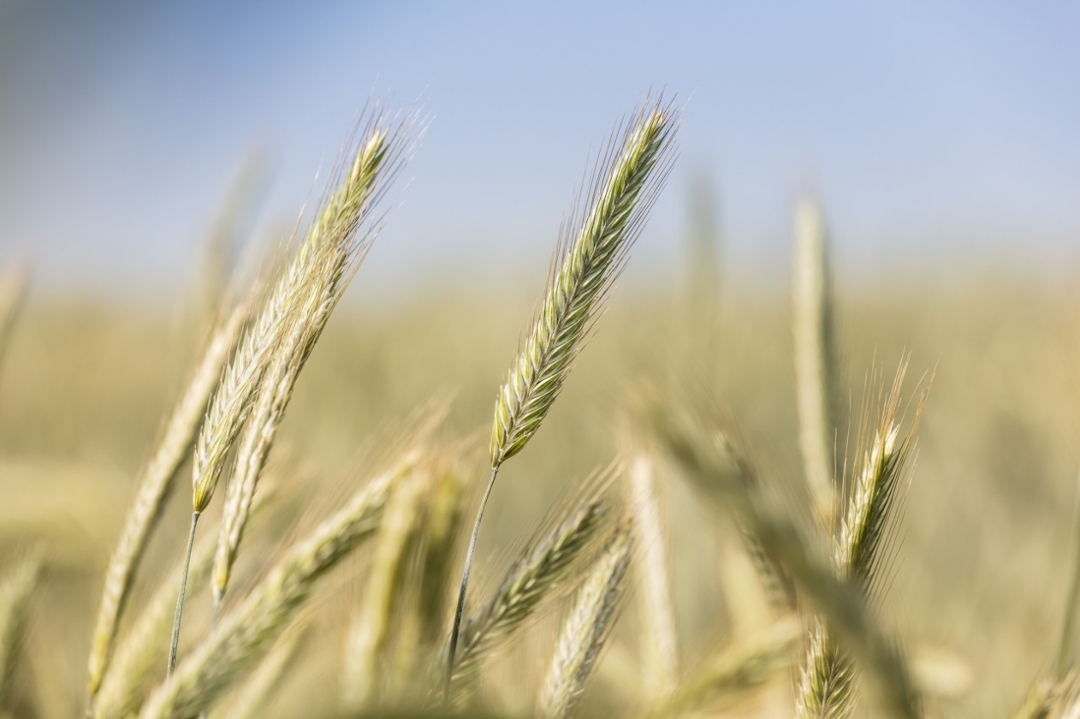
USask scientists help find the key to decoding rye genome
An international team led by the IPK Leibniz Institute in Germany and including University of Saskatchewan (USask) researchers has succeeded in completely decoding the genome of rye, despite its large size and complexity.
Rye is a distinctly climate-resistant cereal plant that is of considerable importance for Germany and northeastern Europe. In Canada, most rye is grown in Saskatchewan and Manitoba.
At USask, the research team includes professor Curtis Pozniak, director of USask’s Crop Development Centre and Ministry of Agriculture Strategic Research Program Chair in Durum and High-Yield Wheat Breeding and Genetics, plant molecular geneticist Andrew Sharpe, director of Genomics and Bioinformatics at USask’s Global Institute for Food Security (GIFS), Sean Walkowiak (Pozniak’s former research officer, now research scientist for Canadian Grain Commission), bioinformatics analyst Brook Byrns, and plant sciences emeritus professor Brian Fowler.
“Rye is one of the most cold-tolerant cereal crops and can survive the harshest winters typical of the Canadian Prairies,” said Pozniak. “The genome sequence of rye points to important genes that could be used to enhance the cold tolerance of other important winter crops, including wheat.”
The results published today in the journal Nature Genetics are promising for both science and breeding. Rye offers access to a diverse gene pool, not only for rye breeding but also for wheat breeding.
“The delivery of the rye genome represents the work of a large and dedicated group of partners across the world,” said Sharpe. “These results are significant, as they provide a complete genome that is closely related to other grass crop species such as wheat and barley, thus allowing a deeper insight into the evolutionary relationships between them.”
All the research data is available to the general public, meaning the extensive genetic diversity of rye can be systematically discovered and used by breeders in a more targeted approach.
“The comparatively low economic importance on a global scale, combined with the great complexity of the genome, interfered with rye getting into the focus of the international research community and thus its genome sequence has been revealed only recently,” explained professor Nils Stein, lead of the research group Genomics of Genetic Resources at IPK and holder of a joint professorship at the University of Göttingen.
Rye shares a close and long evolutionary history with barley and wheat. However, its role as an important crop is much shorter. While barley and wheat were domesticated about 10,000 years ago in the so-called Fertile Crescent of the Near East, rye initially spread to Northern Europe as a weed growing in barley and wheat fields. Gradually, rye adopted the characteristics of its two “big brothers” before becoming a purely cultivated species 5,000-6,000 years ago.
There are important biological differences between rye and its two relatives: rye is fertilized through cross-pollination, thus individual genetic traits cannot be “fixed” as easily as in a self-fertile plant species, and the rye genome is highly complex, which is mainly due to the large number of highly repeated DNA segments.
Knowing the reference sequence makes it easier to transfer positive properties of rye, such as resistances, to wheat without negatively affecting baking properties, for example.
“For example, resistance genes from rye can be transferred to wheat through classical cross-breeding, which has already been used repeatedly in the past,” said Stein. “So the significance of our research extends far beyond rye.”
“The technical prerequisites for sequencing such a complex genome are available today,” Stein emphasized.
The research used homozygous seeds from the plant breeding company KWS SAAT SE & Co. KGaA.
“The new genome sequence of our inbred line Lo7 is a great technological achievement and an important step forward towards a more comprehensive genetic characterisation of this crop,” said Andres Gordillo, lead of rye breeding at KWS.
“It will considerably enhance breeding progress and, therefore, the attractiveness of rye. More specific, it will substantially improve our ability to link resistance traits observed in the field with their underlying genes and their location on the rye genome.”
Parallel to the work of the international research team led by Stein, Chinese researchers created a reference sequence of a Chinese landrace.
“We worked very well with our Chinese colleagues, which ultimately brought great added value for rye breeding and research. We were able to use two different methods to study two very different rye varieties, of which the complete reference sequences are now available,” said Stein. “With these two studies, rye has caught up with barley and wheat and is in the middle of the genome research era.”
Original publications: Rabanus-Wallace et al. (2021), Chromosome-scale genome assembly provides insights into rye biology, evolution, and agronomic potential.
Nature Genetics. DOI: 10.1038/s41588-021-00807-0
Li et al. (2021), Analysis of rye genome sequence sheds new light on its genome expansion and agronomically important genes.
Nature Genetics. DOI: 10.1038/s41588-021-00808-z
At USask, the research team includes professor Curtis Pozniak, director of USask’s Crop Development Centre and Ministry of Agriculture Strategic Research Program Chair in Durum and High-Yield Wheat Breeding and Genetics, plant molecular geneticist Andrew Sharpe, director of Genomics and Bioinformatics at USask’s Global Institute for Food Security (GIFS), Sean Walkowiak (Pozniak’s former research officer, now research scientist for Canadian Grain Commission), bioinformatics analyst Brook Byrns, and plant sciences emeritus professor Brian Fowler.
“Rye is one of the most cold-tolerant cereal crops and can survive the harshest winters typical of the Canadian Prairies,” said Pozniak. “The genome sequence of rye points to important genes that could be used to enhance the cold tolerance of other important winter crops, including wheat.”
The results published today in the journal Nature Genetics are promising for both science and breeding. Rye offers access to a diverse gene pool, not only for rye breeding but also for wheat breeding.
“The delivery of the rye genome represents the work of a large and dedicated group of partners across the world,” said Sharpe. “These results are significant, as they provide a complete genome that is closely related to other grass crop species such as wheat and barley, thus allowing a deeper insight into the evolutionary relationships between them.”
All the research data is available to the general public, meaning the extensive genetic diversity of rye can be systematically discovered and used by breeders in a more targeted approach.
“The comparatively low economic importance on a global scale, combined with the great complexity of the genome, interfered with rye getting into the focus of the international research community and thus its genome sequence has been revealed only recently,” explained professor Nils Stein, lead of the research group Genomics of Genetic Resources at IPK and holder of a joint professorship at the University of Göttingen.
Rye shares a close and long evolutionary history with barley and wheat. However, its role as an important crop is much shorter. While barley and wheat were domesticated about 10,000 years ago in the so-called Fertile Crescent of the Near East, rye initially spread to Northern Europe as a weed growing in barley and wheat fields. Gradually, rye adopted the characteristics of its two “big brothers” before becoming a purely cultivated species 5,000-6,000 years ago.
There are important biological differences between rye and its two relatives: rye is fertilized through cross-pollination, thus individual genetic traits cannot be “fixed” as easily as in a self-fertile plant species, and the rye genome is highly complex, which is mainly due to the large number of highly repeated DNA segments.
Knowing the reference sequence makes it easier to transfer positive properties of rye, such as resistances, to wheat without negatively affecting baking properties, for example.
“For example, resistance genes from rye can be transferred to wheat through classical cross-breeding, which has already been used repeatedly in the past,” said Stein. “So the significance of our research extends far beyond rye.”
“The technical prerequisites for sequencing such a complex genome are available today,” Stein emphasized.
The research used homozygous seeds from the plant breeding company KWS SAAT SE & Co. KGaA.
“The new genome sequence of our inbred line Lo7 is a great technological achievement and an important step forward towards a more comprehensive genetic characterisation of this crop,” said Andres Gordillo, lead of rye breeding at KWS.
“It will considerably enhance breeding progress and, therefore, the attractiveness of rye. More specific, it will substantially improve our ability to link resistance traits observed in the field with their underlying genes and their location on the rye genome.”
Parallel to the work of the international research team led by Stein, Chinese researchers created a reference sequence of a Chinese landrace.
“We worked very well with our Chinese colleagues, which ultimately brought great added value for rye breeding and research. We were able to use two different methods to study two very different rye varieties, of which the complete reference sequences are now available,” said Stein. “With these two studies, rye has caught up with barley and wheat and is in the middle of the genome research era.”
Original publications: Rabanus-Wallace et al. (2021), Chromosome-scale genome assembly provides insights into rye biology, evolution, and agronomic potential.
Nature Genetics. DOI: 10.1038/s41588-021-00807-0
Li et al. (2021), Analysis of rye genome sequence sheds new light on its genome expansion and agronomically important genes.
Nature Genetics. DOI: 10.1038/s41588-021-00808-z
Article re-posted on .
View original article.
